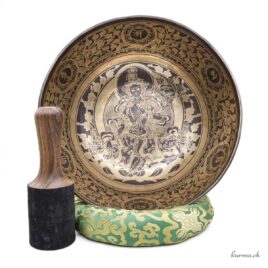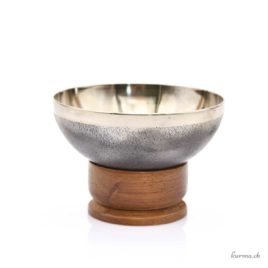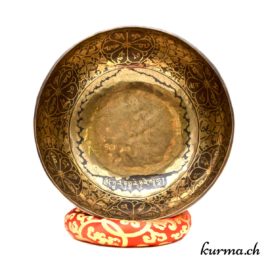
Last products viewed
Engraved singing bowl - Buddha - 22cm - N°4219.5
586.00 CHF
7-metal hammered Tibetan bowl with superb Buddha engraving handcrafted by Nepalese artists using a chisel.
This bowl offers a very interesting sound range for meditation or relaxation.- Origin: Nepal
- Dimensions
- Diameter: 22cm
- Height: 10cm
- Weight: 1.443kg
- Available accessories
- 1 wooden mallet with leather 7cm
- 1 orange fabric cushion
If you'd like additional accessories that don't come with your bowl, you can find them here
Out of stock
Further information
| Provenance |
|---|
Only connected customers who have purchased the product can leave a review.
Similar products
Description
Manufacturing
This Tibetan singing bowl is (like all our forged bowls) a unique, high-quality piece. It is made from a 7-metal alloy "wafer" expertly hammered by blacksmiths near Kathmandu, Nepal.
The engraving was done by hand by local artists.
Composition
Its alloy of 7 different metals contains mainly copper and tin (99%) and minute quantities (0.1%) of iron, lead, mercury, silver and gold.
The right proportion of copper and tin is essential for the sound of the bowl. Other metals are present, according to beliefs, for their energetic and therapeutic virtues.
Use
Singing bowls are musical, wellness, therapeutic, meditative or decorative instruments that can be made to sing by turning a mallet on its outer rim, or by striking it with a mallet or lightly with a mallet.
Here are a few examples of the uses and benefits of these bowls in everyday life:
- To soothe and relax after a stressful day
- To relieve pain (painful menstruation, jammed knee, blocked back, headaches...)
- Purify stones, jewelry, objects...
- To increase the vibratory rate of a food, object or medication
- As an aid to meditation, relaxation, sleep and peace of mind
- To purify and harmonize the energies of your home or workplace
- As a musical instrument
- For sonotherapy (sound therapy)
- For music therapy
- To accompany a yoga session
- Etc...
Instructions for use
There are two ways to make a bowl sing: with a mallet and with a mallet:
With the mallet, simply strike the outer edge of the bowl (upwards), its impact spontaneously vibrates the bowl and its frequencies are diffused in the same way as the impact of a pebble on water.
The mallet enables us to make the bowl sing by turning it while rubbing it around the bowl on the top of the outer rim, exerting fairly strong pressure. If the mallet jumps when the bowl vibrates, slow down or press harder.
The bowl can be placed in front of you on your cushion or on your hand. For this second technique, the hand should be wide open, without rings or other jewelry and the fingers should not be holding the bowl to avoid stopping the vibrations. This technique can be used to move around a room by making the bowl sing, or to move the bowl around a person's body. It can also be placed directly on a person's body or in water.
History and origins of singing bowls
There is no written record of their origins, which date back over 3000 years to the Himalayas, where they were used by shamans and made by nomadic blacksmiths from copper and tin. The manufacture of 7-metal bowls dates back to the 1960s.
Today, singing bowls are mainly used in the West for their beautiful singing and their therapeutic benefits on our physical and subtle bodies.
Bowl size
To make it easier to choose our bowls, we classify them according to weight, as this is one of the most precise criteria. However, to make their identification more visual and intuitive, we mention the diameter in the product title. This makes it easier to identify the physical size of the bowl, even if weight remains our reference criterion.
Want to discover the world of singing bowls? Find out more about Tibetan singing bowls on our blog .








Opinions
There are currently no product reviews.